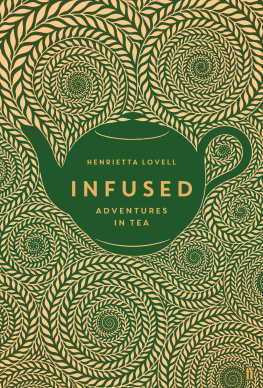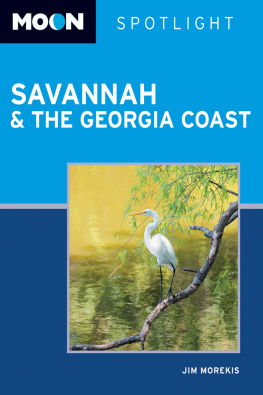This edition is published by Papamoa Press www.pp-publishing.com
To join our mailing list for new titles or for issues with our books papamoapress@gmail.com
Or on Facebook
Text originally published in 1932 under the same title.
Papamoa Press 2018, all rights reserved. No part of this publication may be reproduced, stored in a retrieval system or transmitted by any means, electrical, mechanical or otherwise without the written permission of the copyright holder.
Publishers Note
Although in most cases we have retained the Authors original spelling and grammar to authentically reproduce the work of the Author and the original intent of such material, some additional notes and clarifications have been added for the modern readers benefit.
We have also made every effort to include all maps and illustrations of the original edition the limitations of formatting do not allow of including larger maps, we will upload as many of these maps as possible.
THE GOLDEN ISLES OF GEORGIA
BY
CAROLINE COUPER LOVELL
FOREWORD
CHARLES SPALDING WYLLY of Darien, Georgia, spent the last years of his long life in Brunswick. Sharing the fate of the old, he found it almost impossible to get work, though still strong in body and mind. To divert and interest him, his niece, Mrs. William S. Lovell, suggested that he write his memoirs. He wrote Memories, The Annals of Glynn , and The Seed That Was Sown, which were published through the liberality of his friend, Columbia Downing of Brunswick.
The manuscripts of the first two little books were presented to his niece, with other unpublished data.
After Captain Wyllys death in 1923, as there had been no second edition of these works, it was suggested that Mrs. Lovell should edit them. This she attempted to do, and then decided that it would be better to use the material, add to it, and compile another story. The result is The Golden Isles of Georgia , much of which has been freely quoted from Captain Wyllys writings.
She was also granted the privilege of using the Memoirs of Mrs. Holmes Conrad, by Mrs. Conrads daughters, and of Mrs. George C. Dent, by her granddaughter, Miss Miriam Dent, of Hofwyl, Georgia. Private papers and letters of the Pages and Kings were lent by Mrs. Randolph Anderson of Savannah, and information in regard to the Gould and Cater families was supplied by Mrs. Agnes C Hartridge and Mrs. William H. Shadman of St. Simons.
IGUALE
ALONG the arc of the Georgia coast, from the mouth of the Savannah River to that of the St. Marys, there is a chain of sea islands. On their eastern shores the white surf of the Atlantic rolls ceaselessly, and behind them lie the still waters of inland channels, stretches of quiet marsh, and the mainland.
Two great rivers flow into the sounds between these islandsthe Ogeechee, not far from the Savannah, and the Altamaha, a little more than halfway down the coast. The Altamaha, the nobler stream, is formed by the junction of the Ocmulgee and the Oconee, which rise in northern Georgia. A broad and beautiful river as it nears the sea, its banks are bordered by a dense growth of live oak and cypress, magnolia and bay, all swathed in a tangled cobweb of floating gray moss; and on either bank, beyond the tropical growth of the stream, endless pine forests rise from a thick undergrowth of scrub palmetto.
The islands are as densely wooded as the banks of the Altamaha, though here and there in the interiors are open savannas, covered with harsh wire grass, where palmetto trees stand, dean cut against the burning blue of the Southern sky. And where the land is low there are swamps, in which the spreading knees of the cypress are like Indian tepees, reflected in the wine-dark water. The woods a: filled with the fragrance of myrtle, bay, and jessamine, and the only sounds that break the stillness are the musical notes of birds and the murmur of the wind-surf in the pines.
The soil of these islands is fertile, and in the early days the Indian women who lived on them cultivated small patches of corn, beans, and pumpkins, while their men hunted and fished. These Indians seem to have been docile and peaceably inclined, and offered no resistance when the Spaniards attempted to civilize them.
Following the conquest of Florida, Spain claimed the Atlantic Coast, by right of discovery and occupation as far north as the mouth of the James. In 1526, a short-lived colony was established on the Carolina coast, other expeditions followed, and in 1540 De Sotos imposing cavalcade of mounted cavaliers traversed southern Georgia on its way to the Mississippi in its hopeless quest for gold.
When, in 1562, the French sent over two fleets to establish Huguenot colonies on the Southern coast, Spain challenged the right of France to settle in her realm. Charlefort, which they built on Port Royal Sound, had to be abandoned within the year, while Fort Caroline, near the St. Johns, was destroyed, and its garrison mercilessly massacred.
In 1565, San Augustin was founded by Menndez de Avils, adelantado and captain-general of Florida, and within the year a line of posts was established as far north as Santa Elena, which the Spaniards had named many years before. San Augustin, the oldest city in the United States, was an ecclesiastical offshoot of the diocese of Santiago de Cuba. Both Church and State were anxious to extend the dominion of Spanish power, and with it the spread of Catholicism, Philip II of Spain had learned from the futile Spanish expeditions that the Atlantic Coast offered no wealth of gold or silver, but he thought it expedient to plant his flag in this unknown country and to raise the cross beside it. And so it came about that, as early as 1568, missions were established on the islands of the Georgia coast, and the conversion of the Indians began.
North from San Augustin, the first of the seven large coast islands, now known as Cumberland, was called by the Spaniards San Pedro, its Indian name having been Missoe, which is said to mean sassafras. Next comes Jekyl, which retained its Indian name of Ospo. St. Simons, north of this, which had been Asao, they called San Simon. Sapelo was named Zpala after a province in Spain. St. Catherines Island was known as Santa Catalina, and also as Guale. Ossabaw was the Indian Obispa, and either Skidaway or Tybee, Chatuachee. Santa Catalina was visited the year after the founding of San Augustin by the great Menndez, who was hospitably received by an old Indian named Guale, after whom the island was called. Because of its importance later on as ecclesiastical headquarters, the whole district was called Guale.










